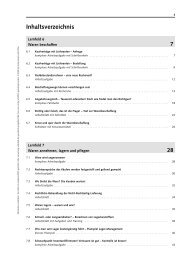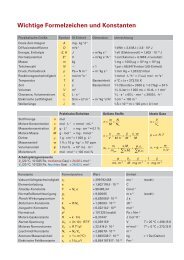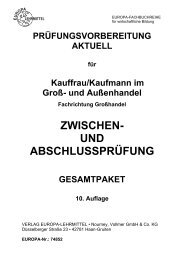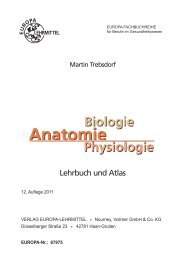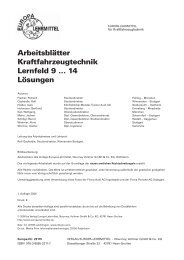Technical English Mechanical Engineering
Technical English Mechanical Engineering
Technical English Mechanical Engineering
You also want an ePaper? Increase the reach of your titles
YUMPU automatically turns print PDFs into web optimized ePapers that Google loves.
Material Technology<br />
3<br />
module<br />
1 2<br />
3<br />
original crystal<br />
lattice<br />
glide<br />
step<br />
crystal lattice during<br />
plastic deformation<br />
3.2 Mechanisms of Deformation<br />
elastically deformed<br />
crystal lattice<br />
crystal lattice after<br />
plastic deformation<br />
and relief of the strain<br />
Picture 3/6: Plastic deformation of a metal<br />
4<br />
glide<br />
step<br />
For some technical tasks, materials need to be<br />
formed. The two possibilities of forming a<br />
material are either elastic or plastic. In case of<br />
elastic deformation, the structure returns to its<br />
original structure once the force has been<br />
removed and in case of permanent deformation,<br />
the structure changes, which is irreversible<br />
(picture 3/6).<br />
Depending on the basic structure (fcc, bcc or<br />
hcp) the atoms move on a level called glide<br />
plane. Every form of the elementary cell moves<br />
in a different direction, and this has the greatest<br />
influence on the ductility of the material.<br />
Picture 3/7 a) shows that the glide plane<br />
always goes through the face-centred cubic<br />
diagonally. This means there are four glide<br />
planes and three directions possible. As one<br />
system consists of one level and one direction, the face centred<br />
cubic has 3 x 4 = 12 gliding systems. This is the structure that<br />
provides a good ductility, since the atoms are nearer to each<br />
other than in any other structure.<br />
Picture 3/7 b) shows a body-centred cubic structure. There are<br />
also 6 x 2 = 12 gliding systems available, but the atoms are not as<br />
close to each other as in the fcc-structure. In reality, there are<br />
48 systems available; but as the packing is not as high as in the<br />
12 systems, they are negligible in this context.<br />
Picture 3/7 c) shows the major gliding plane of the<br />
hexagonally closed packing structure. Here the number of layers<br />
depends on the quotient of height and distance between the<br />
atoms of the elementary cell. With a low height there are more<br />
possibilities of movement than with a large height, but the<br />
strength of the material increases under the condition that the<br />
glide plane dissents from the major planes. In the hcp-structure,<br />
only 1 x 3 = 3 gliding systems are possible. This, in combination<br />
with the fact that changes in the major level have a positive effect<br />
on the strength of the material, is the reason why materials with<br />
an hcp-structure do not provide high ductility.<br />
GD<br />
GD<br />
GD<br />
GP<br />
GP<br />
GP<br />
a)<br />
b)<br />
GP = glide plane GD = glide direction<br />
c)<br />
Picture 3/7: Examples of the gliding planes of cubic and hexagonal crystal lattices<br />
20



